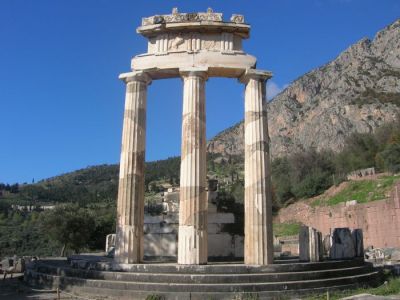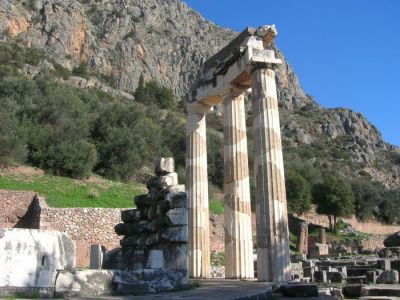|
Fokida

Amfissa is the capital of the prefecture of Phocis and the province of Parnassida, in the so-called Roumeli. The area was known as Salona since the medieval period until the 19th century. Amfissa sits on the northern edge of the farmlands of the Crisaean plain, and lies between two mountains; close by to the west is mount Giona and farther east the Parnassos mountains. The town itself is surrounded by forest, and located south of Lamia, northwest of Livadeia and Delphi, 13 km north of the port of Itea, 30 km north of Desfina, northeast of Nafpaktos, and east of Lidoriki.
Much of the population engages in agriculture and traditional crafts, such as tanning, bell and rope making. The primary agricultural products are olives and goat milk ; Amfissa leads Greece in goat milk production and its olive groves are nicknamed " The Olive Groves of Greece", protected as "places of Delphian Landscape". A variety of olive is named after the city, "Olives of Amfissa" (Elies Amfissis).
The city of Deplhi
(2.500 inhab., 176km, 109 miles from Athens) can be reached by
road through Viotia via Livadia and Arachova. This is the site
of the famous Oracle, where rulers of Greece came for many
centuries for political and moral guidance. The centre of the
complex of temples is the Doric Temple of Apollo dating from
the 4th century BC. The Delphi Museum contains the superb
statue of the Charioteer, circa 475 BC. The Sanctuary of
Apollo in Delphi had been one of the most glorious oracles in
antiquity, along with these of Zeus in Olympia and of Apollo
in Delos. It is situated on the slope of Mount Parnassus,
above the valley of Plisto. It was built during the archaic
period to host the cult of the snake Python, son of Mother
Earth. The place took its contemporary name from the cult of
Apollo Delphinios, i.e. the god worshipped in the shape of a
dolphin.

 Only very few elements of this cult survived. Even
the priestess who delivered the oracles preserved the ancient
name Pythia, whereas later she was also referred to as Sibyl.
The sanctuary soon gained political importance, as it became
the seat of one of the mightiest amphictyoniae, or holy
alliances, and an essential reference point for all the Greek
cities wishing to establish colonies on western Europe. It was
honoured even by Kroisos, the extremely rich king of Lydia, as
well as by the Pharaoh of Egypt, Amasis. The sanctuary has
been the cause of many sacred wars for its control, but its
prestige remained intact. When in 373 BC it suffered serious
damages by an earthquake, many city-states collaborated in
order to restore it. During the Roman period it was honoured
by the first Roman leaders and later by emperors such as
Augustus, Nero and Hadrian. Gradually, however, it fell in
decline. In 385 AD Theodosius outlawed paganism and forbade
the existence of oracles. Since then, "the voice of the
water faded away", as its last priests allegedly have
said. In contemporary times, the excavations at the
archaeological site began in 1892 by a group of French
archaeologists and are still under way. |